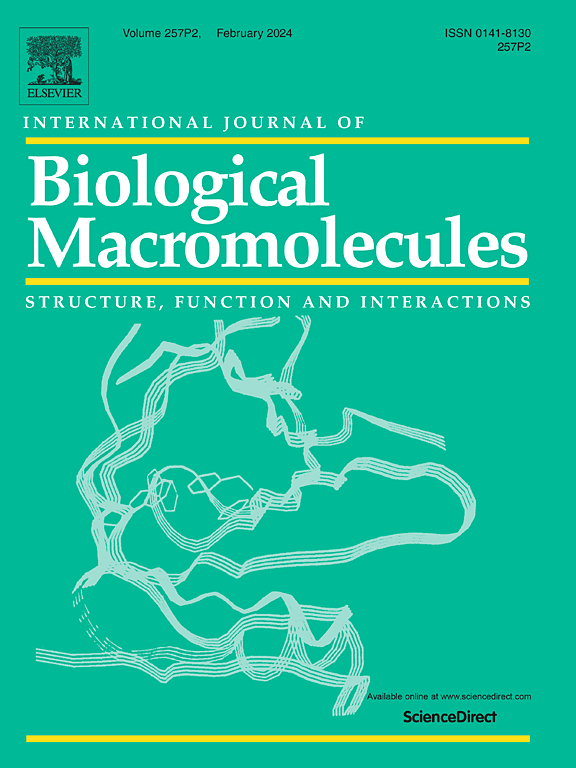Vp1 protein peptide molecule and LAAO in liver cancer gene therapy: VN-NsLAAO fusion protein regulates mir-149-RAS liver cancer cell proliferation pathway
IF 8.5
1区 化学
Q1 BIOCHEMISTRY & MOLECULAR BIOLOGY
International Journal of Biological Macromolecules
Pub Date : 2025-06-01
DOI:10.1016/j.ijbiomac.2025.144819
引用次数: 0
Abstract
Hepatocellular carcinoma (HCC) is a common and highly lethal malignant tumor, and the traditional treatment has limited effect. In recent years, gene therapy as a new treatment strategy for liver cancer has attracted much attention. The role of Vp1 protein peptide and L-amino acid oxidase (LAAO) fusion protein in targeting tumor cell proliferation pathway still needs further study. This study investigated the role of Vp1 protein peptide and LAAO fusion protein (VN-NsLAAO) in liver cancer gene therapy, especially its regulatory mechanism on mir-149-RAS pathway and proliferation of Huh7 liver cancer cells. HN7 cells and HepG2 cells were cultured and treated using a variety of experimental techniques, including plasmid construction, cell transfection, RAPI assay, Western blot, CCK-8 cell activity assay, real-time quantitative PCR, viral recombination assay, and flow cytometry. The expression level of LAAO-related fusion protein was analyzed to compare its inhibitory effect on hepatoma cells, and the specific role of Vp1 protein in tumor inhibition was discussed. The results showed that VN-NsLAAO fusion protein was effectively expressed in Huh7 cells and had significant anti-cancer targeting properties. Compared with NsLAAO, VN-NsLAAO showed enhanced nuclear penetration in Huh7 cells and showed specific interactions against miR-149. Further analysis showed that VN-NsLAAO mediated the inhibition of Huh7 cell proliferation by down-regulating the expression of RAS. Both in vivo and in vitro experiments showed that the anti-liver cancer effect of VN-NsLAAO-rAAV8 was better than that of traditional drug PDD.
Vp1蛋白肽分子与LAAO在肝癌基因治疗中的作用:VN-NsLAAO融合蛋白调控mir-149-RAS肝癌细胞增殖途径
肝细胞癌(HCC)是一种常见的高致死率恶性肿瘤,传统的治疗方法效果有限。近年来,基因治疗作为一种新的肝癌治疗策略备受关注。Vp1蛋白肽和l -氨基酸氧化酶(LAAO)融合蛋白在靶向肿瘤细胞增殖通路中的作用还有待进一步研究。本研究探讨Vp1蛋白肽与LAAO融合蛋白(VN-NsLAAO)在肝癌基因治疗中的作用,特别是其对mir-149-RAS通路及Huh7肝癌细胞增殖的调控机制。采用质粒构建、细胞转染、RAPI实验、Western blot、CCK-8细胞活性实验、实时定量PCR、病毒重组实验、流式细胞术等多种实验技术对HN7细胞和HepG2细胞进行培养和处理。分析laao相关融合蛋白的表达水平,比较其对肝癌细胞的抑制作用,并探讨Vp1蛋白在肿瘤抑制中的具体作用。结果表明,VN-NsLAAO融合蛋白在Huh7细胞中有效表达,具有明显的抗癌靶向性。与NsLAAO相比,VN-NsLAAO在Huh7细胞中表现出增强的核穿透能力,并对miR-149表现出特异性相互作用。进一步分析表明,VN-NsLAAO通过下调RAS表达介导Huh7细胞增殖抑制。体内和体外实验均表明,VN-NsLAAO-rAAV8的抗肝癌作用优于传统药物PDD。
本文章由计算机程序翻译,如有差异,请以英文原文为准。
求助全文
约1分钟内获得全文
求助全文
来源期刊
CiteScore
13.70
自引率
9.80%
发文量
2728
审稿时长
64 days
期刊介绍:
The International Journal of Biological Macromolecules is a well-established international journal dedicated to research on the chemical and biological aspects of natural macromolecules. Focusing on proteins, macromolecular carbohydrates, glycoproteins, proteoglycans, lignins, biological poly-acids, and nucleic acids, the journal presents the latest findings in molecular structure, properties, biological activities, interactions, modifications, and functional properties. Papers must offer new and novel insights, encompassing related model systems, structural conformational studies, theoretical developments, and analytical techniques. Each paper is required to primarily focus on at least one named biological macromolecule, reflected in the title, abstract, and text.

 求助内容:
求助内容: 应助结果提醒方式:
应助结果提醒方式:


